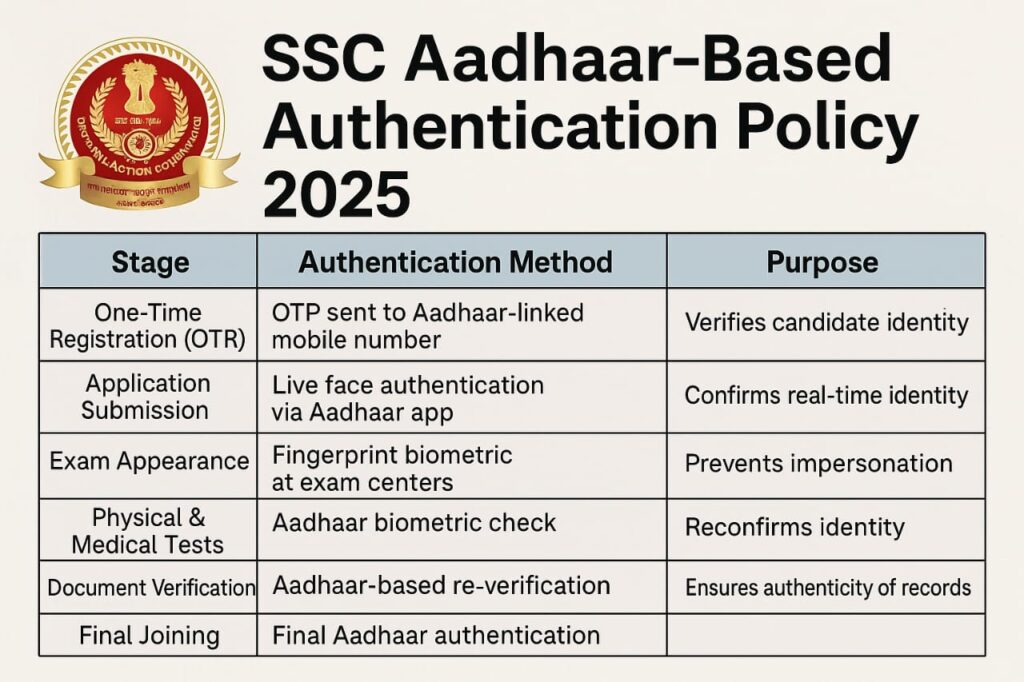The Staff Selection Commission (SSC) has introduced a new Aadhaar-based authentication policy for all candidates appearing in SSC exams. This move aims to streamline the selection process, eliminate fraud, and make government recruitment more efficient and secure. In this article, we’ll explore what this new policy means for candidates, its benefits, implementation stages, and what happens if a candidate chooses not to authenticate with Aadhaar.

Why Aadhaar-Based Authentication is Being Introduced
The SSC’s Aadhaar authentication system is designed to address multiple issues plaguing the recruitment process. And here are the key reasons for its implementation:
- Standardization: Aadhaar helps create a uniform identification system across all stages of recruitment.
- Fraud Prevention: The new system combats impersonation and identity fraud.
- Smooth Exam Process: Ensures that exams are conducted securely and fairly.
- Efficient Selection: Reduces delays in the recruitment process by enabling faster verification.
Stages of Aadhaar-Based Authentication in SSC Exams
The authentication process is spread across various stages of the SSC recruitment cycle. As you can see the structured overview here:
| Stage | Authentication Method | Purpose |
| One-Time Registration (OTR) | OTP sent to Aadhaar-linked mobile number | Verifies candidate identity |
| Application Submission | Live face authentication via Aadhaar app | Confirms real-time identity |
| Exam Appearance | Fingerprint biometric at exam centers | Prevents impersonation |
| Physical & Medical Tests | Aadhaar biometric check | Reconfirms identity |
| Document Verification | Aadhaar-based re-verification | Ensures authenticity of records |
| Final Joining | Final Aadhaar authentication | Completes identity verification |
Benefits of Aadhaar-Based Authentication for SSC Candidates
There are several advantages to opting for Aadhaar authentication:
- Transparency: A more trustworthy and fair selection process.
- Ease at Exam Centers: Reduced scrutiny and faster entry procedures.
- Photo/Signature Issues: Minor errors in photos or signatures may not lead to rejections.
- Relaxed Reporting Time: Candidates may be allowed entry even if they arrive slightly late.
What If You Don’t Use Aadhaar for SSC Authentication?
SSC has made Aadhaar authentication optional, not mandatory. However, those who don’t use it must be prepared for a longer, more manual process.
| Challenge | Alternative or Requirement |
| No Aadhaar Card | Use PAN Card, Voter ID, or Driving License |
| Data Not Auto-Filled | Manually fill name, father’s name, gender, DOB multiple times |
| Verification Time | Report up to 2 hours earlier than Aadhaar-authenticated candidates |
| Document Requirement | Carry 2–3 ID documents with clear photos and matching names |
Should You Choose Aadhaar Authentication?
The video strongly recommends opting for Aadhaar-based authentication due to the convenience and efficiency it offers. From faster application processing to reduced identity-related hassles, the Aadhaar route ensures a smoother recruitment experience.
Final Closure
The SSC Aadhaar-based authentication policy is a forward-looking move towards a more digital, secure, and reliable recruitment process. While it’s not mandatory, using Aadhaar can save candidates time and reduce the risk of document mismatches or identity errors. Those without Aadhaar are still eligible to apply but should prepare for a few extra steps.
Frequently Asked Questions (FAQs)
Q1: Is Aadhaar authentication mandatory for SSC exams in 2025?
A: No, it is optional. However, Aadhaar authentication is highly recommended due to the ease and benefits it provides.
Q2: Can I appear in SSC exams without Aadhaar?
A: Yes, but you must carry alternate documents like PAN, Voter ID, or Driving License and report earlier.
Q3: What happens if I face photo mismatch issues?
A: The new system is more lenient, and minor issues may not lead to rejection.
Tags:
#SSC2025 #AadhaarAuthentication #SSCRecruitment #SSCTips #GovernmentJobsIndia #ExamUpdates #DigitalVerification






